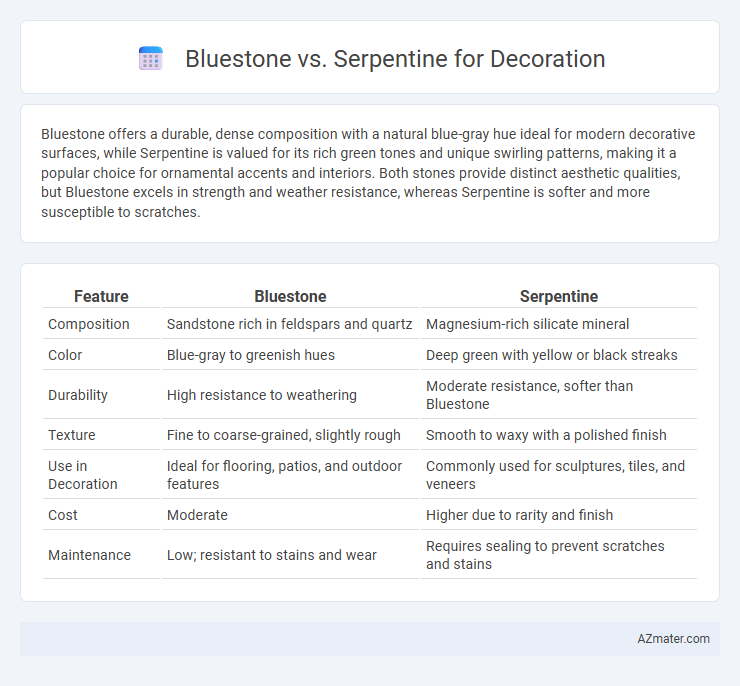Bluestone offers a durable, dense composition with a natural blue-gray hue ideal for modern decorative surfaces, while Serpentine is valued for its rich green tones and unique swirling patterns, making it a popular choice for ornamental accents and interiors. Both stones provide distinct aesthetic qualities, but Bluestone excels in strength and weather resistance, whereas Serpentine is softer and more susceptible to scratches.
Table of Comparison
| Feature | Bluestone | Serpentine |
|---|---|---|
| Composition | Sandstone rich in feldspars and quartz | Magnesium-rich silicate mineral |
| Color | Blue-gray to greenish hues | Deep green with yellow or black streaks |
| Durability | High resistance to weathering | Moderate resistance, softer than Bluestone |
| Texture | Fine to coarse-grained, slightly rough | Smooth to waxy with a polished finish |
| Use in Decoration | Ideal for flooring, patios, and outdoor features | Commonly used for sculptures, tiles, and veneers |
| Cost | Moderate | Higher due to rarity and finish |
| Maintenance | Low; resistant to stains and wear | Requires sealing to prevent scratches and stains |
Introduction to Bluestone and Serpentine
Bluestone is a dense, durable sandstone commonly used in outdoor landscaping and decorative applications due to its natural blue-gray color and versatility. Serpentine, a metamorphic rock rich in magnesium and iron, features distinctive green hues and smooth, waxy textures that make it popular for ornamental stone and interior decor. Both stones offer unique aesthetic qualities and physical properties, making them suitable for various decorative purposes in architecture and design.
Geological Origins and Composition
Bluestone is a dense, fine-grained sandstone primarily composed of quartz and feldspar, formed through sedimentary processes over millions of years in regions such as the northeastern United States and parts of the UK. Serpentine is a metamorphic rock rich in magnesium and iron silicates, characterized by its smooth texture and greenish hues, originating from altered ultramafic rocks in areas like the Appalachian Mountains and Italy's Alps. The distinct geological origins and mineral compositions of bluestone and serpentine influence their durability, coloration, and suitability for decorative applications in architecture and landscaping.
Appearance and Color Variations
Bluestone features a deep blue to gray color palette with subtle hints of green, providing a sleek and modern aesthetic ideal for contemporary decor. Serpentine showcases rich green tones with swirling patterns that range from light chartreuse to dark emerald, creating a natural and vibrant accent. Both stones offer unique textures and color variations that enhance decorative surfaces, with bluestone lending a polished, uniform look and serpentine adding dynamic, organic visual interest.
Durability and Strength Comparison
Bluestone offers superior durability due to its dense, fine-grained composition, making it highly resistant to chipping, cracking, and weathering in outdoor decorative applications. Serpentine, while valued for its unique, variegated patterns and softer texture, tends to be less hard and more susceptible to scratching and erosion over time. The strength of bluestone ensures long-lasting structural integrity and minimal maintenance, whereas serpentine requires careful handling and is better suited for indoor or low-impact decorative uses.
Suitability for Indoor and Outdoor Use
Bluestone offers exceptional durability and weather resistance, making it highly suitable for both indoor flooring and outdoor landscaping projects, including patios and garden pathways. Serpentine provides a softer, more decorative finish ideal for indoor applications such as countertops and wall cladding but requires more maintenance outdoors due to its susceptibility to weathering. Choosing bluestone ensures long-lasting performance in varied climates, while serpentine enhances aesthetic appeal in controlled indoor environments.
Maintenance and Care Requirements
Bluestone requires regular sealing and occasional cleaning with pH-neutral detergents to maintain its appearance and prevent staining, making it moderately high-maintenance for decorative use. Serpentine, known for its durability and natural resistance to weathering, demands less frequent sealing but should be cleaned gently to avoid surface damage from harsh chemicals. Both stones benefit from routine dusting and prompt spill cleanup to prolong their aesthetic appeal and structural integrity in decorative settings.
Cost and Availability
Bluestone offers moderate affordability and widespread availability in construction supply stores, making it a cost-effective choice for decorative projects. Serpentine tends to be more expensive due to its unique coloration and limited quarry sources, resulting in less availability and higher prices. Choosing bluestone can optimize budget and sourcing efficiency while serpentine serves premium aesthetic needs with increased investment.
Popular Decorative Applications
Bluestone and serpentine are favored for decorative applications due to their unique textures and colors. Bluestone's durability and natural blue-gray tones make it ideal for patios, walkways, and outdoor fireplaces, enhancing modern and rustic aesthetics. Serpentine's rich green hues and smooth finish are popular for interior countertops, tiles, and accent walls, providing a striking contrast in luxury home decor.
Environmental Impact and Sustainability
Bluestone and serpentine differ significantly in environmental impact and sustainability; bluestone quarrying often results in less habitat disruption and lower carbon emissions due to localized extraction and minimal processing requirements. Serpentine's mining can be more environmentally intensive, involving substantial energy use and potential heavy metal contamination risks, especially chromium, which challenges sustainability efforts. Selecting bluestone for decorative use supports eco-friendly landscaping by reducing ecological footprint and promoting sustainable resource utilization in construction and design projects.
Choosing the Right Stone for Your Project
Bluestone offers a dense, durable surface with rich blue-gray hues ideal for outdoor patios and walkways, promoting longevity and a natural aesthetic. Serpentine features a softer, greenish tone with a smooth texture, suitable for interior decorative elements like countertops and wall cladding where elegance and unique veining are desired. Selecting the right stone depends on project requirements such as durability, color preference, and intended use, with Bluestone favored for heavy-traffic areas and Serpentine chosen for visually striking indoor applications.

Infographic: Bluestone vs Serpentine for Decoration
 azmater.com
azmater.com